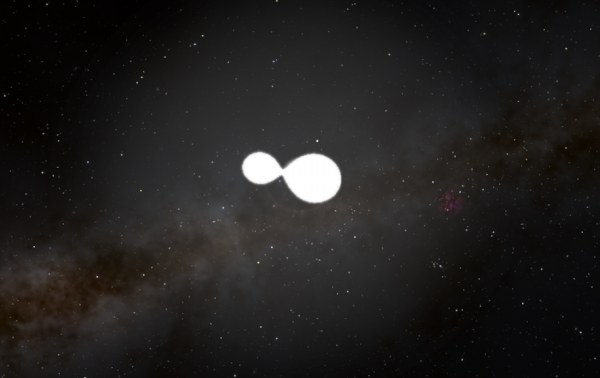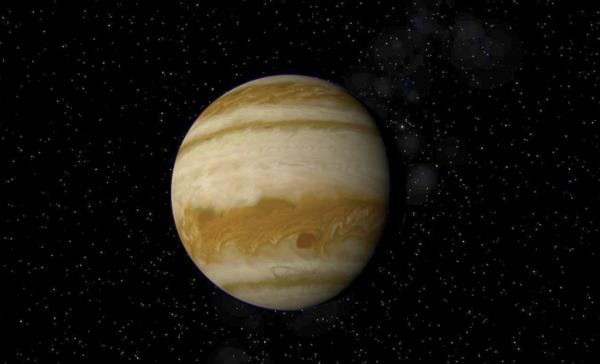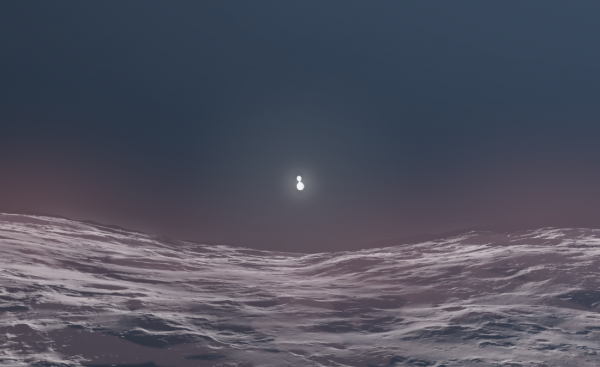BY LETTER
Freedonia
Galactography > Regions of Space > Middle Regions/Hinter-regions
Galactography > Systems and Worlds > Systems & Worlds E - F
Galactography > Systems and Worlds > Systems & Worlds E - F
Contact binary system in Antlia | |
 Image from Steve Bowers | |
| S Antliae is a contact binary star. The two stars share material and are slowly spiralling towards each other | |
Freedonia (S Antliae) System | |
| Stars | Names: Freedonia Components: 2 (Contact Binary) 1) Freedonia (S Antliae A) 2) Libertia (S Antliae B) Location: - Distance from Sol: 260.7 ly (J2000) - Constellation: Antlia Freedonia Names: Freedonia, S Antliae A, HD 82610 A, HIP 46810 A, HR 3798 A Physical characteristics: - Mass: 1.94 x Sol - Radius: 2.026 x Sol - Spectral type: A8 V - Luminosity: 13.69 x Sol (bolometric) - Temperature: 7,800 Kelvin - Age: 6 billion years Libertia Names: Libertia, S Antliae B, HD 82610 B, HIP 46810 B, HR 3798 B Physical characteristics: - Mass: 0.76 x Sol - Radius: 1.322 x Sol - Spectral type: A9 V - Luminosity: 4.570 x Sol (bolometric) - Temperature: 7,340 Kelvin - Age: 6 billion years Freedonia-Libertia binary orbit Orbital characteristics: - Average separation: 2,300,000 km - Period: 15.6 hr - Eccentricity: 0.66 |
|---|---|
| System | Planets 1) Losenbasen: AmmonoJovian - Semi-major axis: 9.41 AU - Orbital period: 17.56 years - Eccentricity: 0.31 - Inclination from binary plane: 65 degrees - Mass: 0.356 x Jupiter - Radius: 61015 km ( 9.57 x Earth ) - Obliquity: 19 degrees - Rotational period: 12.8 hours - Irradiance from star: 0.2 x Earth Moons: 1) Tacolia: Radius 2101 km 2) Hautna: Radius 1981 km 2) Atmen: CryoazurianJovian - Semi-major axis: 27.7 AU - Orbital period: 0.196 years - Eccentricity: 2.74 - Inclination from binary plane: 74 degrees - Mass: 0.21 x Jupiter - Radius: 45313 km - Obliquity: 23.1 degrees - Rotational period: 12.8 hours - Irradiance from star: 0.059 x Earth Moon: 1) Sylvania |
The S Antliae system was colonised in 2477 AT by a joint NoCoZo/Sophic League mission, drawn by the unusual characteristics of this double star. Although the two components of this star were once very different in temperature and spectral type, they have slowly spiralled closer together over time until they are in contact, becoming a contact binary with a common photosphere. Both elements of this star now shine with the spectral characteristics of an A-type star, although they are different in size and luminosity. These two stars together form a so-called W Ursae Majoris variable object, with a distinct luminosity curve as seen from certain angles.
This system contains two gas giants in wide, eccentric, highly inclined orbits; Losenbasen, an Ammo-Jovian world, and Atmen a Cryoazurian-Jovian world. Any planets which may have existed closer to the stellar pair have been ejected or subsumed as the pair grew closer together, due to various momentum exchange mechanisms. Both giant planets have a wide range of different types of moons which have been colonised in various ways or mined for the construction of habitats and spacecraft. The joint NoCoZo/Sophic administration named this system Freedonia, but after two centuries they declared themselves independent of both empires and seceded from Sephirotic influence.
In 2844 the Freedonian Expansion Initiative sent a colony mission towards TYC 7212-290-1, a system with a rich debris field more than five hundred light years further into the Antlia sector. This colony became Avanola, the gateway to the Xacounian Expansion. The FEI also colonised half-a-dozen other systems in outer Antliae, eventually leading to the establishment of the Gentry Hardline Polity and the Zendart Dominion. But Freedonia itself became little more than a stepping stone to these independent, rival empires, especially as it was on the wormhole trunk-route that led to them..
 Image from Steve Bowers | |
| Losenbasen, a gas giant in this system | |
The autonomous bubblehabs remained active however, and by 7600 a new population of modosophonts had made their homes in these capacious structures. But in due course the new tenants determined that the previous occupants had not left, but instead they still existed in the memories and dreams of the organic habitats. In most cases the new tenants have become quite accustomed to the shadowy presence of these wandering memories.
 Image from Steve Bowers | |
| Sunrise in Freedonia | |
Related Articles
Appears in Topics
Development Notes
Text by Steve Bowers
Initially published on 31 October 2020.
Freedonia and Sylvania are named after imaginary countries in the Industrial Age movie Duck Soup.
Initially published on 31 October 2020.
Freedonia and Sylvania are named after imaginary countries in the Industrial Age movie Duck Soup.






